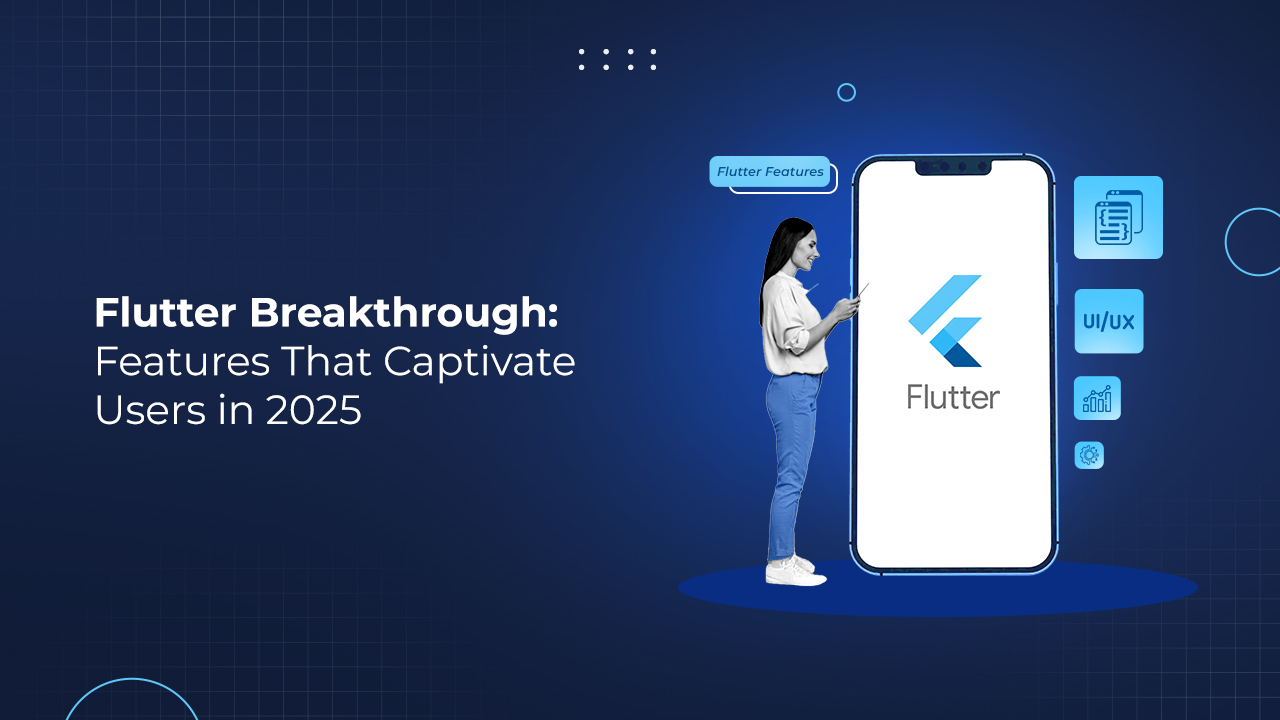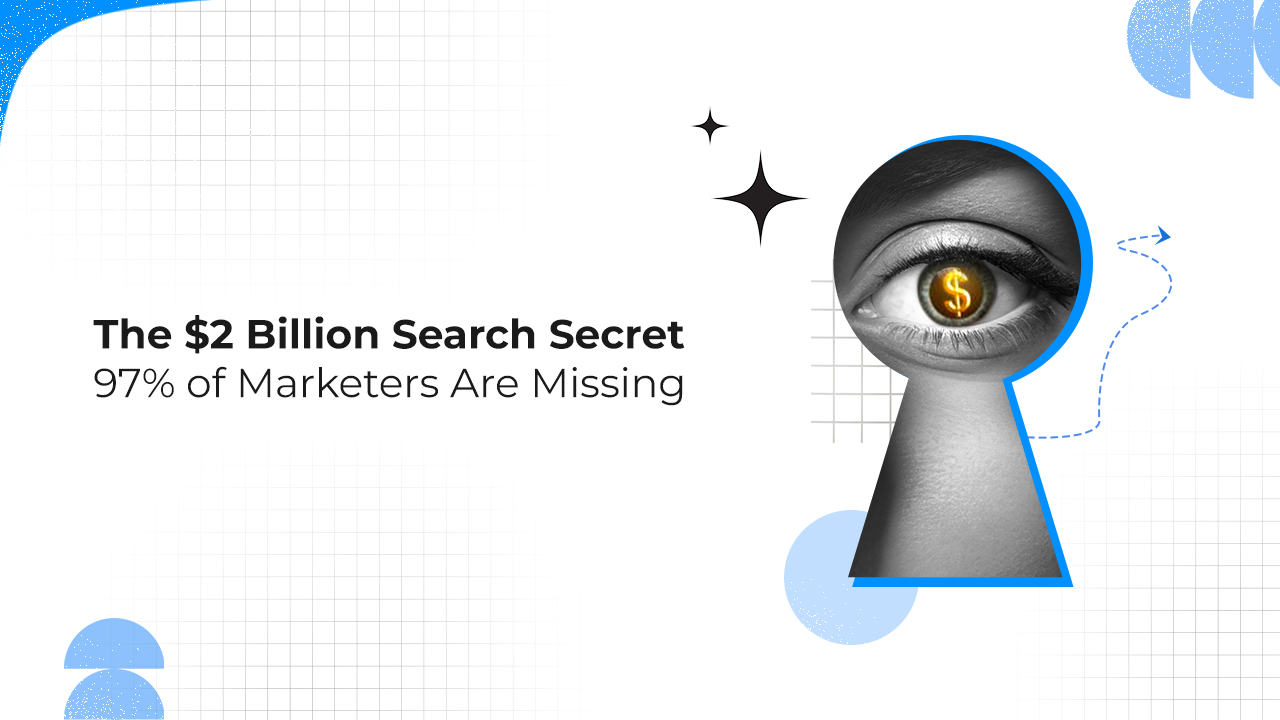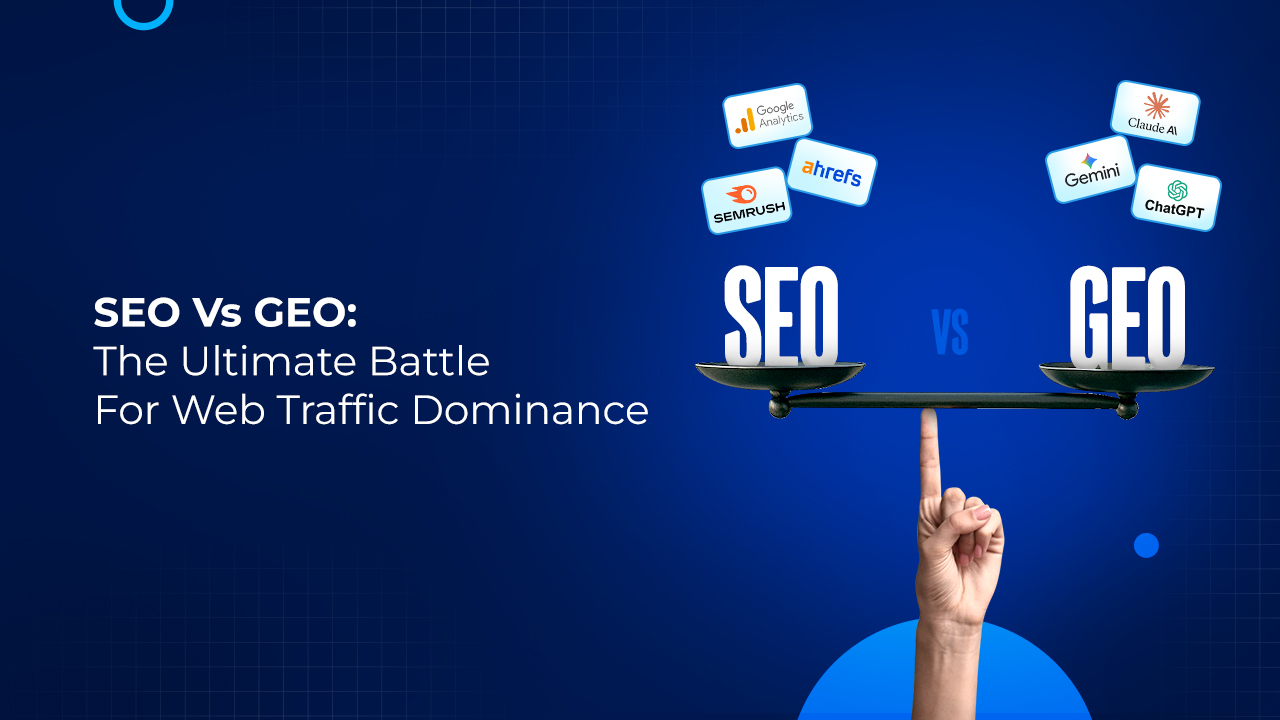
GEO vs SEO: The Ultimate Battle for Web Traffic Dominance
Between 2024 and 2025, the GenAI traffic to retail websites skyrocketed to more than 3500%, according to the Economic Times. So, there’s a hot debate going on about GEO vs SEO.
This spike in traffic was even seen in other sectors like banking, technology, and finance.
This GenAI traffic behaves quite differently. It is more exploratory, more engaged, with a lower chance of converting immediately. This signals a new kind of search behavior.
Is there an invisible influence?
GenAI is summarizing content while providing direct answers. In fact, 80% of the users rely on these AI summaries for about 40% of their searches. They seem to bypass the conventional websites altogether.
So, there is indeed an invisible influence of AI on the users!
Does that mean SEO services are obsolete now?
Does that mean SEO is dead?
SEO isn’t quite dead; it’s evolving. While traditional SEO still drives traffic and leads, new shifts like AI overviews and generative search engines are reshaping how content is discovered. To stay visible, businesses must combine SEO services with GEO (Generative Engine Optimization), adapting strategies for both search engines and AI platforms.
Before delving into GEO and other topics, let’s explore whether SEO is dead or not!
Is SEO Dead?
If you want to get high-value leads for your services, SEO is the way to go. With the help of SEO content such as blogs, you can get quality leads for your business. According to a HubSpot report, 60% of marketers say that inbound SEO strategies helped them score the highest number of leads for their companies. Plus, SEO leads have a 14.6% close rate.
This is how important SEO is! Do you think something like this will ever be dead?
You must be familiar with the term Search Engine Optimization (SEO). Are you not? Don’t worry! Hear us out.
For more proven strategies, check out our 10 Proven SEO Tips to Instantly Boost Your Website Rankings
What is SEO, or search engine optimization?
SEO helps search engines understand your content, so that they can connect it with the users who are looking for information through search queries.
Didn’t get it? Don’t worry. Here’s a simplified version for you.
Suppose you Google “15 best movies to watch on Netflix”. You click the search icon in the search bar and boom! Hundreds of blogs and articles answering your question appear right in front of you.
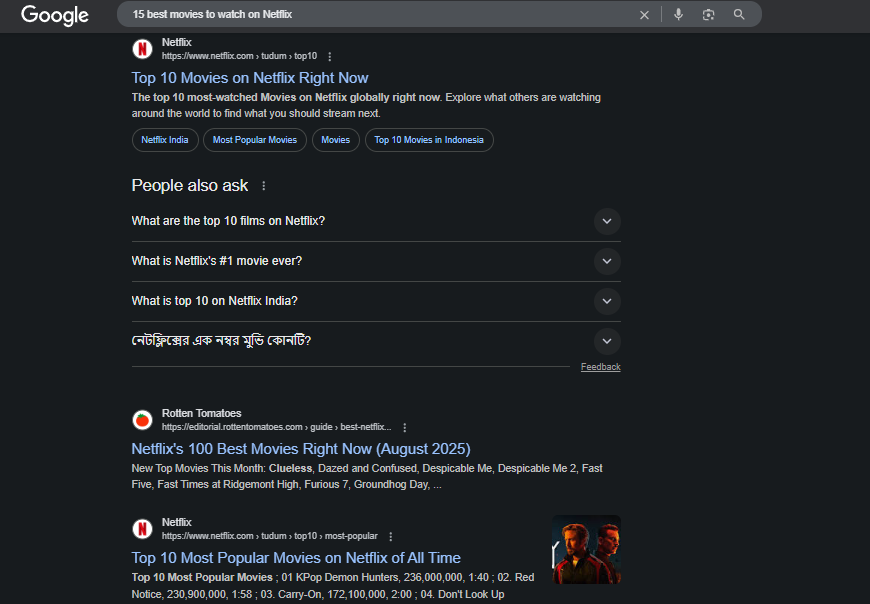
This is how it looks. These are the top results!
But do you ever browse blogs and go to the third page? Well, most of us don’t!
According to Backlinko, 50% of users click on the results within just 9 seconds of searching. Can you believe that? Today’s users have such short attention spans! This means that most users don’t even leave the first page of Google.
So, the articles or blogs that rank at the top of the page get the most clicks. That means the businesses publishing it get the upper hand of being seen first and have the opportunity to make a great first impression.
But, why do some content rank on the first page itself while other gets lost in other pages? Well, it’s not random! There are a lot of factors considered by Google’s algorithm that determine the ranking. Search Engine Optimization (SEO) is all about those factors.
However, if you provide an exceptional user experience to your visitors, your content will rank for sure in Google. So, SEO’s sole purpose is to give the visitors the information they want in the easiest way possible.
Is SEO Really Dead?
By now, you probably have an idea about SEO.
Google’s algorithm is constantly changing. It is introducing 13 algorithms (average) a day! Why so? Because of Gen AI tools like Claude and ChatGPT and social media platforms like Amazon and TikTok!
So, conventional SEO cannot tackle such changes. To succeed, you have to adapt!
Traditional SEO was working just fine until Google introduced AI overviews in 2024. How do AI overviews work?
They collect information from multiple web sources and give the users concise answers. That too, at the top of the search results!
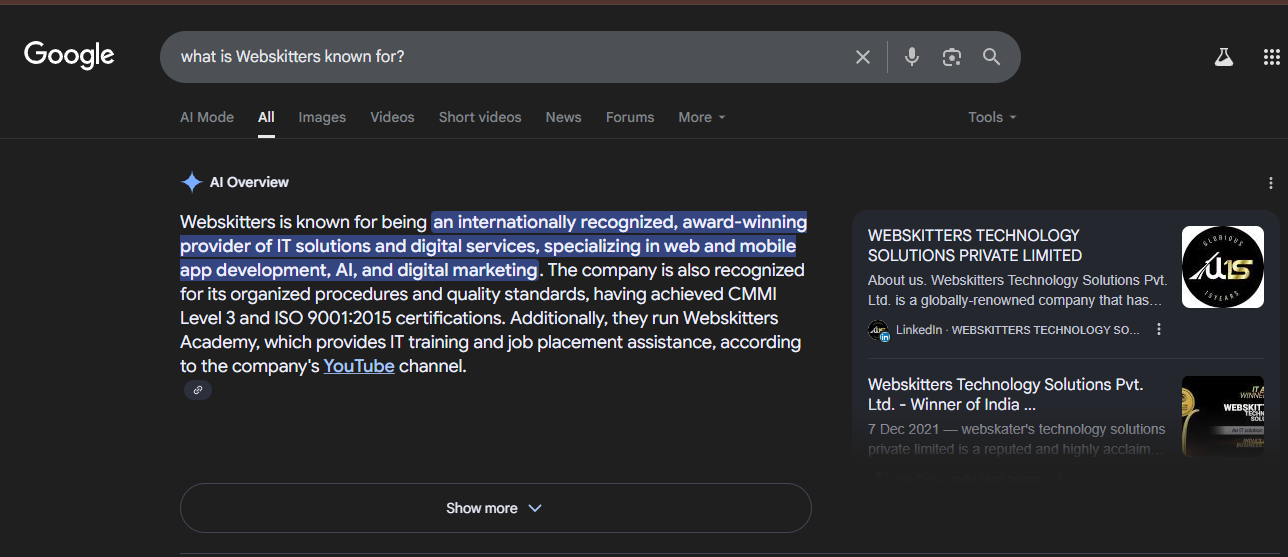
This is how an AI overview looks.
So, these AI overviews are going to kill SEO, right? Absolutely not! While they are shaking things up a bit, the relevance of SEO will not diminish.
Is social media a threat to SEO? No, you have to know how to use it for your SEO efforts. See, Google is not where all your users are. Platforms like Reddit and TikTok are also places where users search for content.
Even YouTube is a search engine in itself. So, social media platforms are indeed reshaping SEO.
The real question is: Are you reshaping your SEO strategies too? The fact is, Google goes beyond its own dataset to look for content that is needed by the users. So, they also spot content on these platforms.
Hence, SEO is not dead and never will be. You just have to realign your strategy considering these factors.
Although various engines need to be optimized for a successful strategy, we will talk about Generative Engine Optimization and how it helps!
Why GEO is the Talk of the Town?
Though GEO is in its experimental phases, the early adopters can reap huge benefits. That’s why businesses are pushing to integrate GEO in their visibility and content optimization strategies. But, first things first, we have to understand what GEO is.
What is GEO?
GEO stands for Generative Engine Optimization. It is a strategy of getting featured on generative engines or GenAI search platforms like ChatGPT, Claude, Gemini, Perplexity, or AI overviews.
It is quite different from traditional SEO. How is GEO different from SEO?
Instead of focusing on ranking content in traditional searches (SEO), GEO focuses on creating content for GenAI tools. This will allow these tools to feature the content in the form of answers when user asks questions to them.
However, it is important to note that GEO is still an emerging strategy and is not yet an established approach.
The success of a GEO strategy depends on how frequently your content is cited in AI responses. This reflects the visibility of your content in conversational searches.
What goes into a GEO strategy?
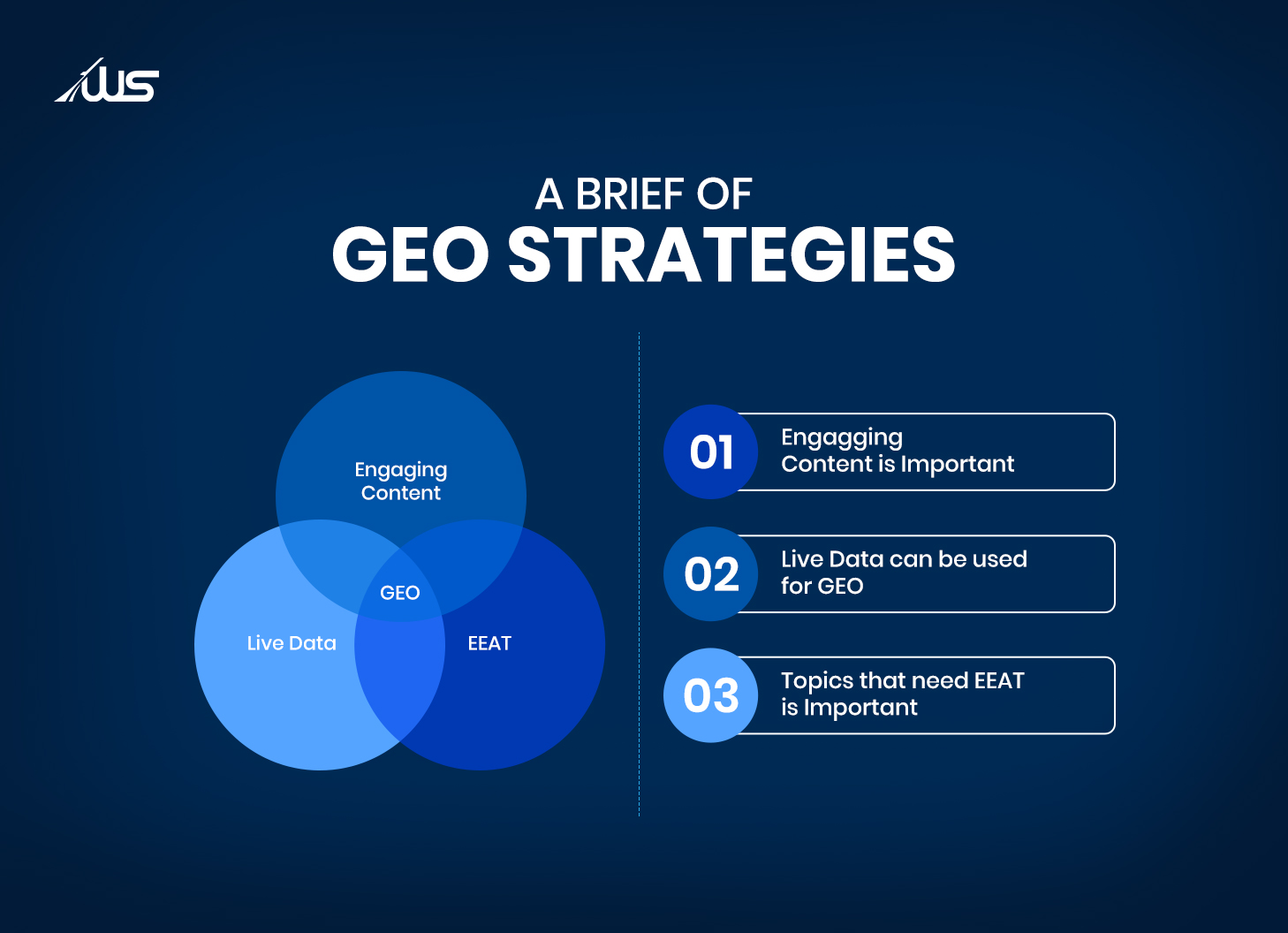
- Engaging content is your doorway to a successful GEO campaign.
- Live data like flight delays, hotel room availability, and prices can be used for generative engine optimization.
- Topics that need EEAT (Experience, Expertise, Authoritativeness, and Trustworthiness) should be incorporated into your GEO strategy.
Is GEO Popular Today?
In this debate of GEO vs SEO, the question of the hour is whether GEO is popular today or not!
Is GEO as popular as SEO?
Is GEO more popular than SEO?
No, generative engine optimization is not as popular as SEO. This is because it’s a relatively new concept that complements the SEO strategy.
But instead of being that, you can’t deny that 71% of managers use generative AI regularly in 2025. This was 65% in early 2024. Gen AI is increasingly being used in sales, marketing, product development, software development, and operations.
What about other users? A study cited by Search Engine Land reports that 71.5% of users use AI tools for search, and 14% use them regularly. Even the CTRs are reducing, which shows a rise in zero-click searches.
So, optimizing your content for generative engines or Gen AI is more important than ever. And, yes, GEO marketing is a thing!
What about the demographics of the audience using GenAI for searches?
GEO is becoming important, as evidenced by a significant rise in AI searches. People search AI platforms to find products and answers online. Some of them skip the traditional search altogether.
Google still dominates the search market, and it is a fact!
However, what’s interesting is the demographic factor. Here’s the data from 700+ people surveyed:
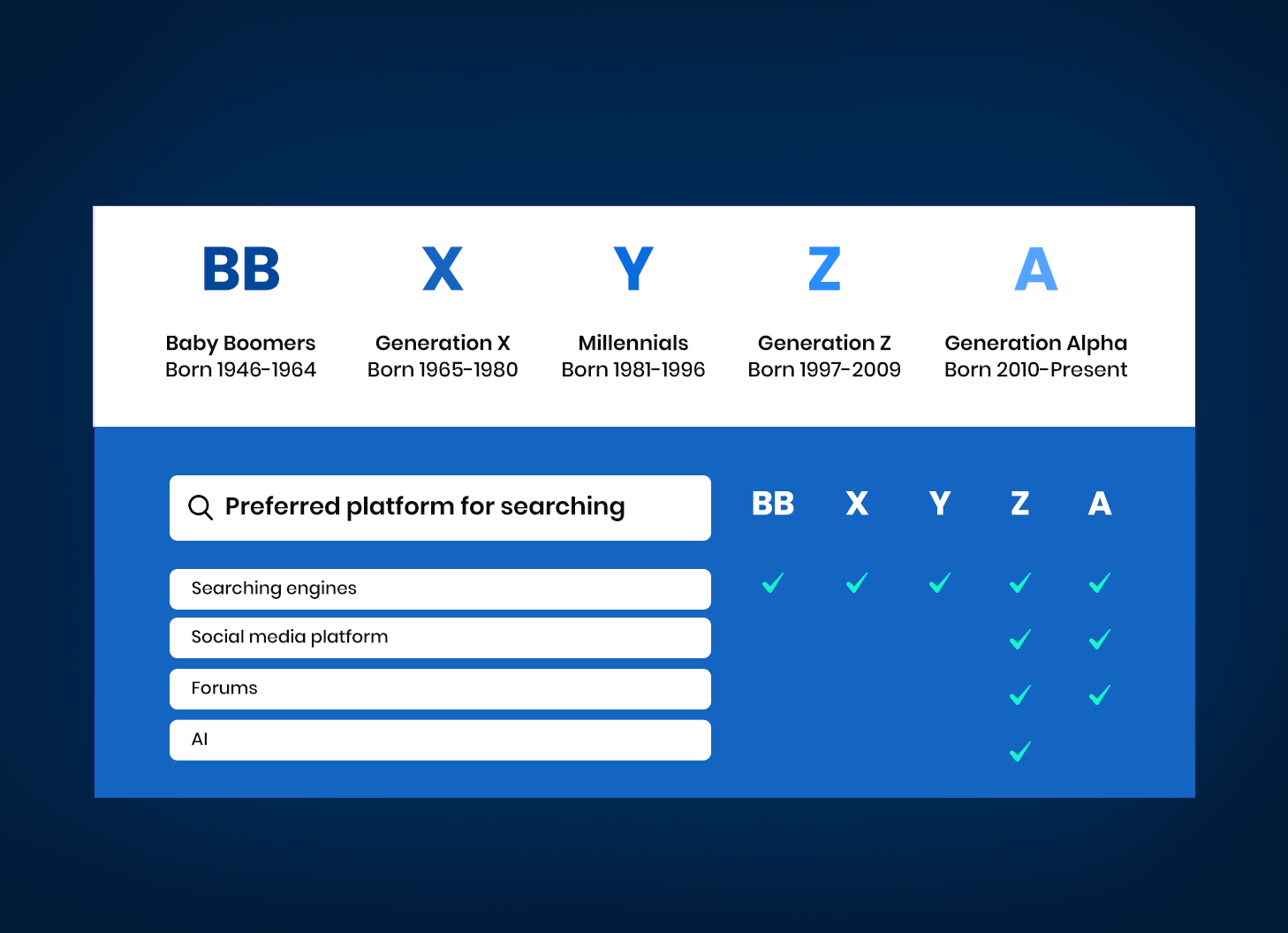
- Baby Boomers (1946-1964) – This section primarily sticks to traditional search engines.
- Generation X (1965-1980) – This generation also searches on traditional search engines.
- Millennials (1981-1996) – The millennials look for information from traditional search engines.
- Gen Z or Zoomers (1997-2009) – The Zoomers look for information online from social media platforms, forums, and GenAI, along with traditional search engines.
- Gen Alpha (2010-Present) – These people use search engines and social media platforms only to search.
Note: All this data is based on a total number of 700 people surveyed from different generations.
From this, we can say that the younger generations are most interested in AI searches. So, if your target audience is from this generation, GEO is mandatory.
GEO vs SEO: What’s Similar?
Are GEO and SEO completely different, or are they similar? Let’s explore that!
How are GEO and SEO similar?
GEO and SEO both have the common goal of producing content that meets the user requirements.
Both these optimization strategies start with understanding user questions and crafting relevant answers to those questions.
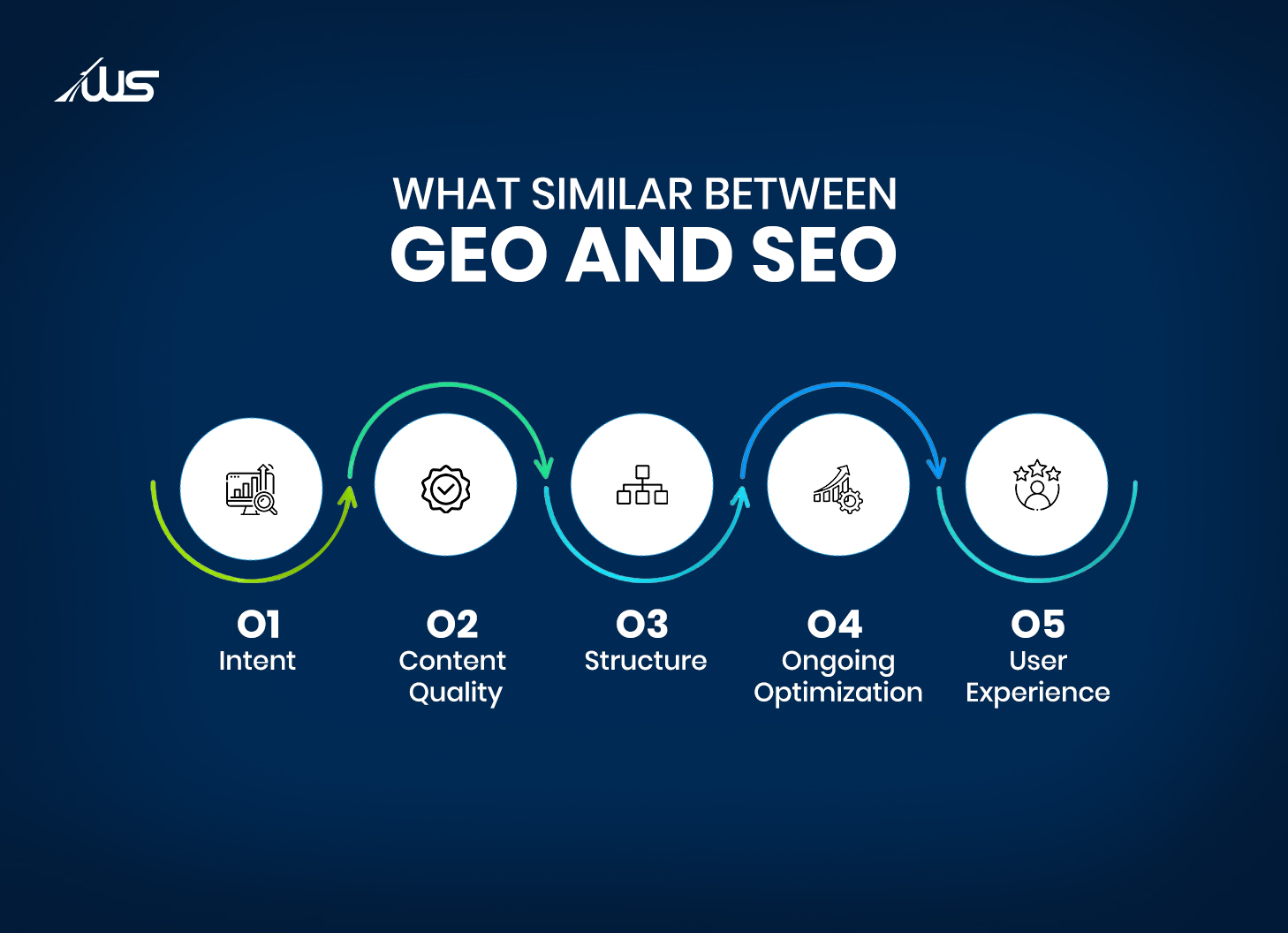
1. The Shared Goal is to satisfy the Intent!
Focusing on intent makes sure that the user gets the relevant information. Be it your web page from search engines or your content from the AI response, it’s important that they find the information they need.
2. The Quality of the Content Isn’t Negotiable!
Both search engine algorithms and generative AI models favor well-researched, up-to-date, and accurate information in the content.
Taking your time to check the facts, maintain clarity, and cite relevant sources boosts your rankings on both traditional searches and AI systems.
3. Lack of Structure makes your Content Invisible!
A logical flow with clear subheadings and headings helps the crawlers get your content’s context and relevance. This also allows AI models to extract facts with ease.
Well-structured content goes well for both people and machines. So, both the GEO and SEO demand concise paragraphs, summary boxes, and relevant bullet points.
4. Ongoing Optimization is Paramount!
Regular refinement and monitoring are important in both optimization strategies. This is because the algorithm periodically evolves, and AI re-trains itself from new data.
How do you know when to update your content?
Reviewing metrics like CTRs, search rankings, or AICF (AI Citation Frequency) helps you identify the time to:
- Update content
- Add insights
- Restructure the content
This ongoing assessment is crucial for keeping the content competitive for both traditional engines and AI platforms.
5. User Experience Cannot be Ignored!
UX (user experience) is the king when it comes to content.
Whether someone visits your web page or reads an AI summary that has your content, the ultimate goal is to deliver value to your users.
So, prioritizing accuracy, readability, and clear communication by which you can easily satisfy your users and signal trustworthiness to both generative and search engines, offers a great user experience.
How to Win in Generative Engine Optimization (GEO)?
Don’t you worry! GEO is not rocket science. A lot of SEO strategies help you win in GEO. So, integrating them into your workflow can be useful.
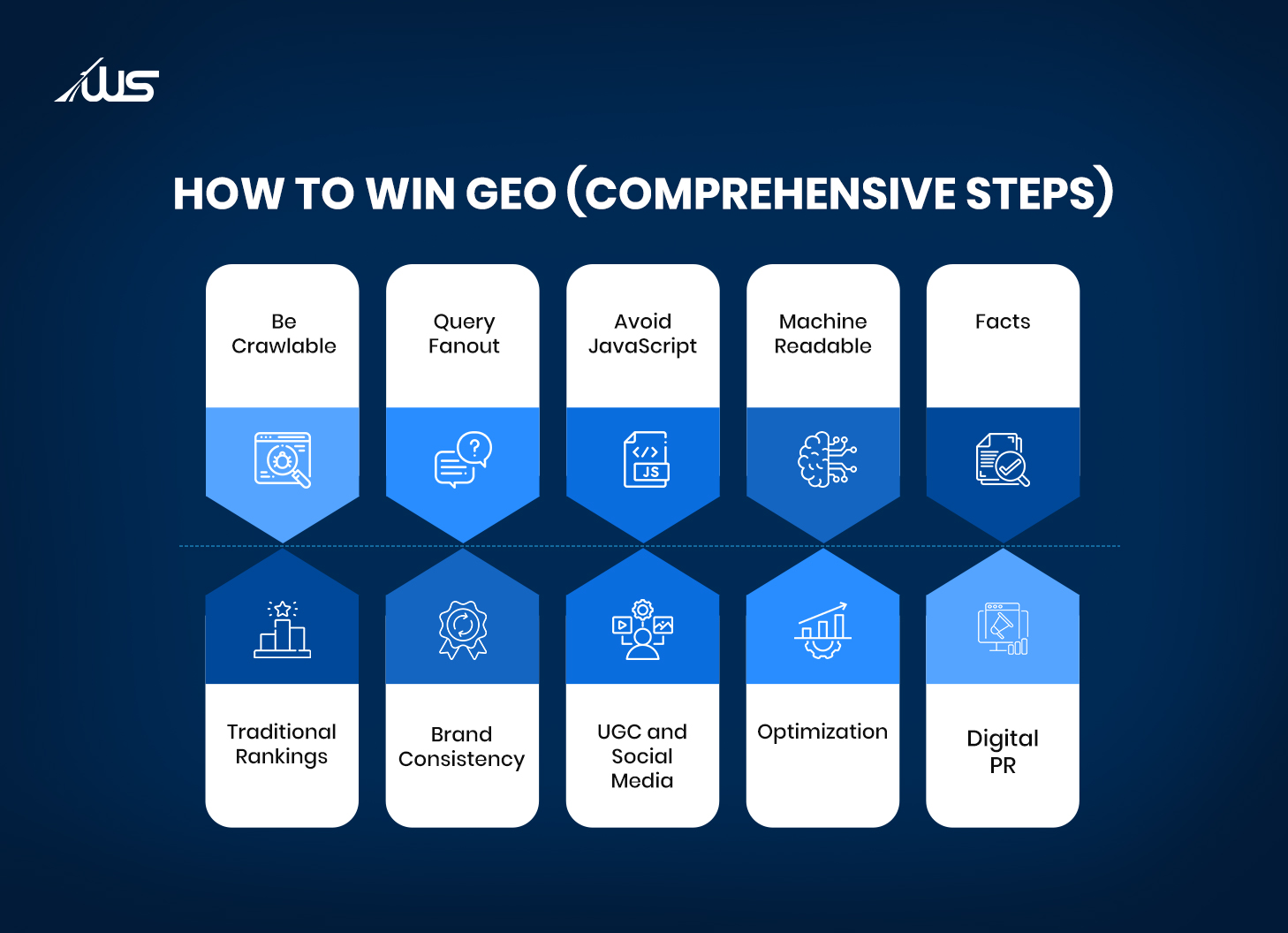
Step 1: Just Be Crawlable
Despite being simple, this step is the foremost step to an effective GEO strategy. If you want the most visibility in GenAI, you will have to make them crawl your website.
However, some of these AI crawlers seem aggressive. So, they can trigger DDoS prevention and scraping. So, strategize with your IT team and find a way to allow relevant AI crawlers.
Step 2: Gain Traditional Rankings
This one’s simple, right? However, it’s one of the most important steps. Do the conventional SEO and rank well in Bing (ChatGPT and CoPilot), Google (AI Overviews and Gemini), Brave (Claude), and Baidu (DeepSeek).
Step 3: Targeting the Query Fanout
What is Query Fanout?
The query fanout is a technique that Google’s AI uses. Google filed a patent in 2024, which is close to query fanout. In that, they called this technique thematic search.
Query fanout or thematic search is the system that organizes search results for a query into categories. These categories are called themes. The themes provide a summary for each theme. This allows the users to understand the answers without a click.
For example, we asked ChatGPT, “What is the latest Google patent discussed by SEO?”
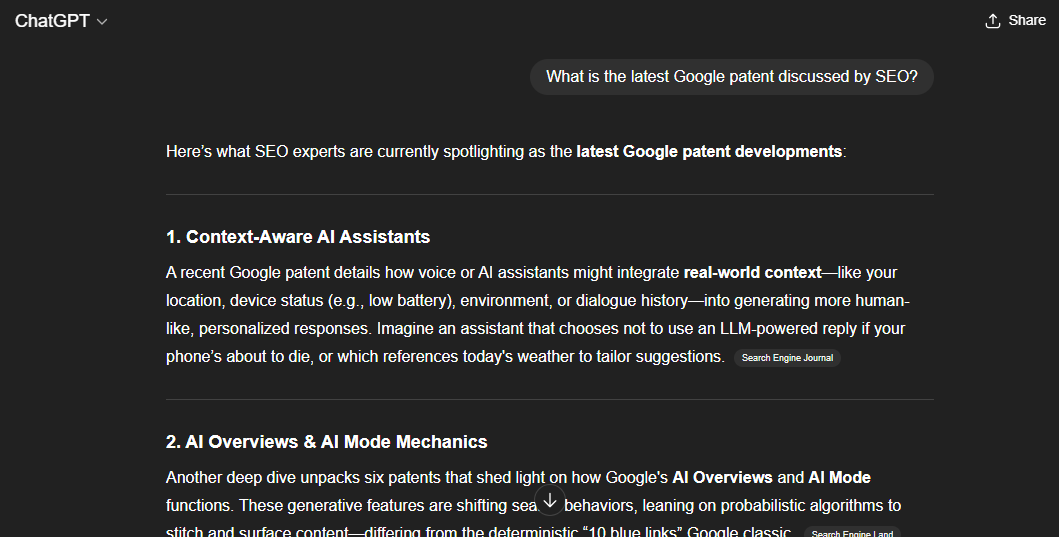
It retrieves results from these articles to provide summarized content:
- Google Patent On Using Contextual Signals Beyond Query Semantics
- How AI Mode and AI Overviews work based on patents, and why we need a new strategic focus on SEO
- Google’s “Branded Search” Ranking Factor Patent
- Google Patents & Research Papers
Additional Suggestion: Check typical query fanouts for the prompt and try to rank on those keywords.
So, targeting the query fanout can help you rank in GenAI.
Step 4: Keep the Brand Mentions Consistent
Everyone should follow this. It doesn’t matter if you’re doing GEO for your personal website or for your business. Be sure that your brand is described in the same light, everywhere.
Be it on X, Crunchbase, Clutch, GitHub, LinkedIn, or your website, you always have to describe yourself in the same way.
Step 5: Avoiding JavaScript
If you think avoiding JavaScript as much as possible is important in SEO, then avoiding it in GEO is crucial.
Most LLM crawlers cannot render JavaScript. So, if your content is hidden behind JavaScript, you will be lost forever in the eyes of these crawlers.
Step 6: Leverage User-Generated Content and Social Media
The LLM crawlers rely on Wikipedia and Reddit a lot. Both these platforms have UGC (User Generated Content) on every topic (literally). And, due to efficient moderation, most of this content is spam and junk-free.
Along with that, the UGC has better readability, and they are updated regularly. Even Reddit provides LLM crawlers with data on user behavior, language, and knowledge on different topics.
So, if you can use these platforms without spamming, you can reasonably stand out when it comes to both GEO and SEO.
Step 7: Content that’s Quotable and Machine Readable Should be crafted
You have to produce content that the LLM crawlers will understand and cite. No one has a complete understanding of how it works. Here’s what we know.
- You have to use factual and declarative language. For instance, instead of writing “We are kind of sure that this shoe is good for athletes”, you have to say “98% of athletes have reported that they are satisfied with this shoe”.
- The addition of Schema is useful. Although this is a hot debate among GenAI enthusiasts, experts have confirmed that Schema helps LLMs understand the content.
- If you want your content on AI overviews on a topic that already exists, you have to develop content of the same length. However, we aren’t saying that you must copy the exact content, but crafting similar content helps.
- In case you’re using technical terms in the content, make sure to simplify them.
- The addition of long paragraph summaries, tables, videos, and reviews can help in winning in GEO.
Step 8: Content Optimization
To be cited by the GenAI, it helps a lot if you:
- Add unique words
- Include pros and cons
- Gather reviews
- Quote experts
- Use quantitative data and mention sources
- Use easy language
- Write positively
- Include lists
- Inclusion and following all the above points help a lot for LLMs to crawl and index your content.
Step 9: Adhere to facts
The algorithms have taken knowledge from texts. Texts that contradict known facts can seem untrustworthy to them.
So, you have to aim for facts that are already established. However, you can add unique facts to your content. This is ideal for LLM crawlers to rank your content.
Hence, stick to facts and add unique information to the content.
Step 10: Investing in Digital PR
Every step mentioned is not just for your personal website. It is also applicable to the content for all other websites out there.
So, how to influence all that?
Through Digital PR!
The more your brand gets coverage, the more likely it is that the LLM crawlers will rank your content in GenAI.
Why is this true? We have seen that advertorials are also cited as sources for GenAI results.
So, we can say that it’s not essentially GEO vs SEO but GEO + SEO.
If you think that GEO will replace SEO, you’re wrong!
However, GEO is not an option anymore. It’s a necessity for organic growth. But ignoring your SEO strategies is not going to do you any good. You have to evolve your SEO strategies to align them with GenAI platforms.
SEO means Search Everywhere Optimization now. Is your Strategy Keeping Up?
While it is true that SEO has evolved, that doesn’t mean that SEO is dead. Instead, it is very much alive and evolving every day.
Social media, GenAI platforms, search engines, forums, and other platforms are where users search today instead of sticking to search engines only. And, the rise of zero-click searches proves just that!
So, the new SEO is not Search Engine Optimization, but it means Search Everywhere Optimization.
And, guess what? It includes GEO as well.
So, it’s never GEO vs SEO but GEO plus SEO.
How to maintain control?
Instead of sticking to the factors you can’t change, focus on enhancing your SEO strategies by aligning them with GEO.
One smart way to do that is by tightening up the technical side—starting with Core Web Vitals. Curious how? Dive into our blog on 10 Core Web Vitals Optimization Tactics to Skyrocket Your SEO.
This adoption of Search Everywhere Optimization will take time. However, it’s worth giving your time to that. This will future-proof your content strategies.
Do you want to know more about the ways you can enhance your SEO and GEO strategies? Webskitters Technology Solutions is here to help!
Book a call with our SEO experts to watch your ROI skyrocket with Search Everywhere Optimization.
FAQs
1. Is SEO dead in 2025?
No, SEO is not dead. It’s evolving alongside AI and social media trends.
2. What is GEO in digital marketing?
GEO (Generative Engine Optimization) focuses on optimizing content for AI search platforms like ChatGPT, Claude, and Gemini.
3. How is GEO different from SEO?
SEO targets rankings on search engines, while GEO aims to get content cited in AI-generated answers.
4. Why is GEO important now?
With 71% of users relying on AI tools for search, GEO boosts visibility in conversational queries.
5. Should businesses choose SEO or GEO?
It’s not SEO vs GEO. You need both to stay competitive in search and AI-driven discovery.

 Ecommerce Development
Ecommerce Development 
